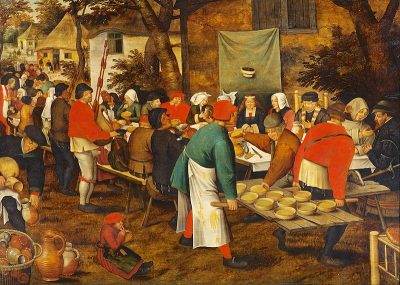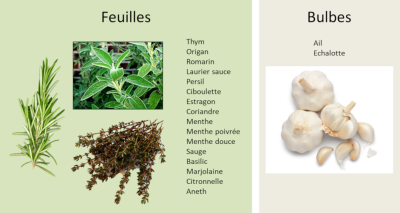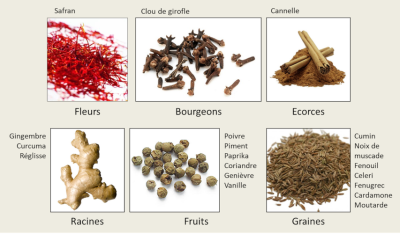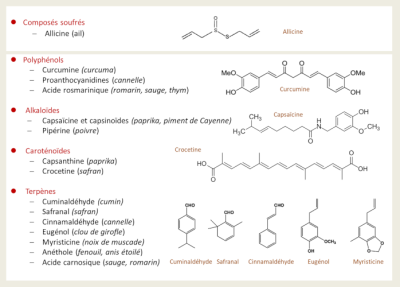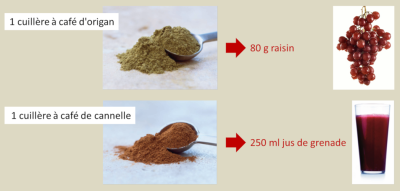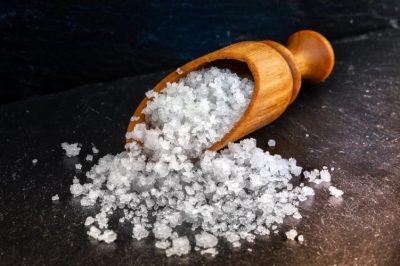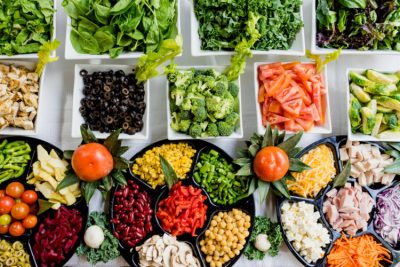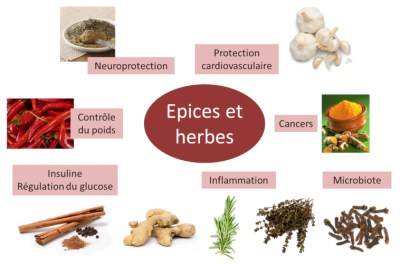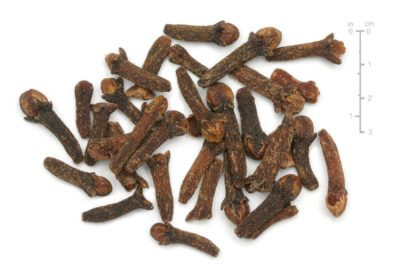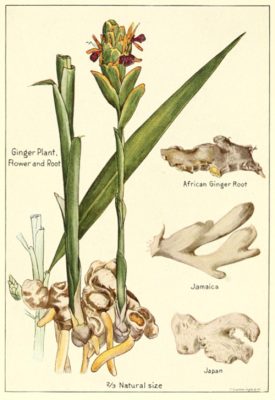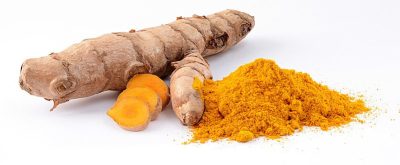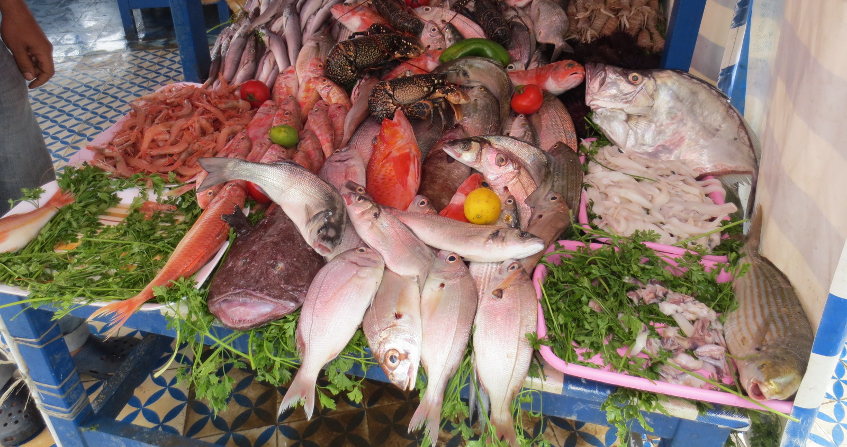Spices and aromatic herbs : what benefits for our health ?
PDF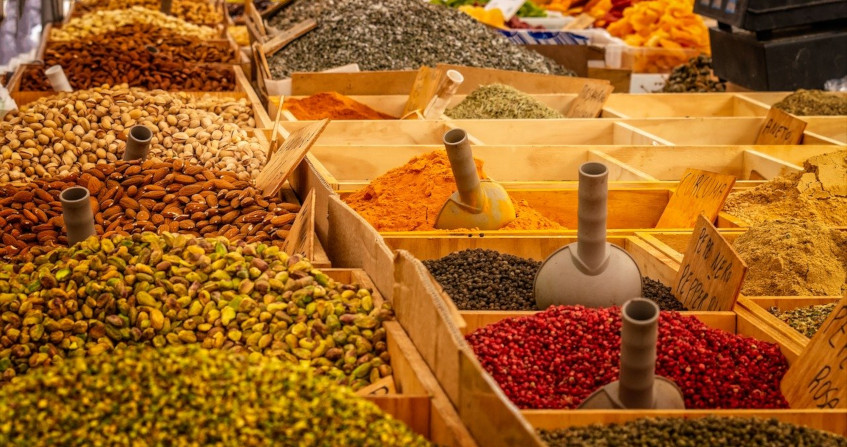
Used for pleasure, spices and culinary herbs provided by our environment also have amazing nutritional qualities that contribute to human health. Their fragrant and strong-tasting compounds often participate in the defence of the plant that produces them against environmental damage. Ingested in our food, they largely keep their bioactive properties: for example, they have antioxidant properties useful to our health. They reduce the risk of so-called civilizational diseases such as obesity, type 2 diabetes, cardiovascular diseases and, as very recently demonstrated, they promote the growth of the “good” bacteria of our microbiota. In addition, spices reduce the amount of fat, salt and sugar in our cooking thanks to the intensity of their aromas and flavours.
1. Discovering herbs and spices
1.1. Spices and civilization
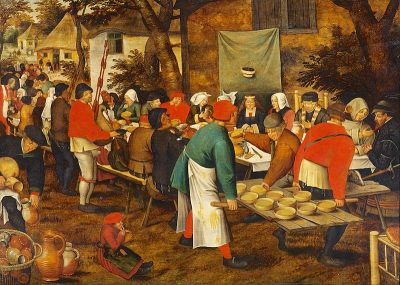
Until the 20th century, the use of spices remained essentially hedonistic (flavour, perfume) in contrast to herbs whose medicinal virtues have been known in Europe since the Middle Ages (Figure 1).
1.2. Herbs, spices, a subject of interest in Public Health
It is only recently that we have had scientific studies that report the potential public health benefits of herbs and spices. This work focuses on three main areas:
- the analytical aspect and the identification of bioactive compounds in spices and herbs;
- the behavioural aspect with their role in following the nutritional recommendations of the High Council of Public Health (HCSP) [2]: less salt, fat, sugars, more vegetables and legumes;
- the biological and clinical aspect with studies demonstrating their ability to prevent or alleviate diseases.
1.3. What is a spice or an aromatic herb?
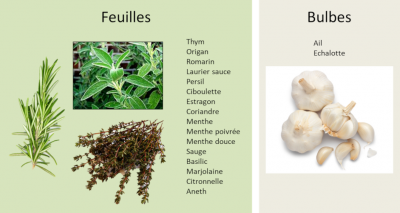
Often found in vegetable gardens or market garden stalls, aromatic herbs are used for their aromatic, condiment or medicinal qualities, sometimes combined in aromatic mixtures (Figure 2). Their active ingredients are present in the leaves (parsley, bay leaf sauce, chives, …) or bulbs (garlic, shallot, onions). In cooking, the bouquet garni is used to flavour a stewed dish. Composed of various herbs, it usually contains bay leaves, thyme and parsley.
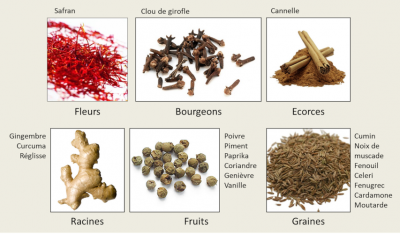
It should be noted that spices stimulate our senses not only thanks to the fragrant or sapid compounds* they contain, but above all, compounds with a trigeminal* action, which distinguishes them from aromatics. They are therefore responsible for odours (orthonasal: through the nostrils; or retronasal: through the retronasal fossae, which connect the mouth to the nose), flavours, and stimulation of the trigeminal nerve (pungent, fresh…). [4]
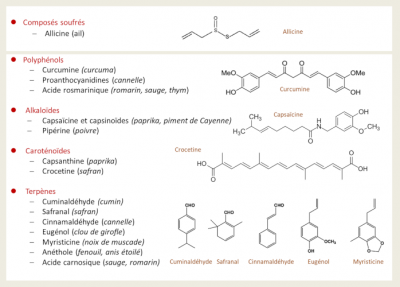
Their secondary metabolites within the plant, have a protective role against thermal, bacterial or viral stress. For example, the curcuminoids in turmeric powder, of which curcumin is the best known to the public, are first of all protectors of the plant which, when exposed to aggression, change its cellular signalling and induce antioxidant and anti-inflammatory defences. This mechanism is common in the plant kingdom and, by incorporating spices into our food, we benefit from these properties.
1.4. Herbs and spices, sources of dietary antioxidants
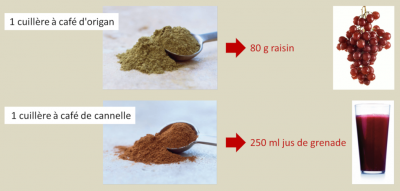
2. Herbs and spices for less salt, less sugar, less fat, more vegetables
Poor food choices increase the risk of nutrition-related diseases such as obesity, type 2 diabetes, high blood pressure, inflammatory diseases, cancers or more recently studied, alterations of the intestinal microbiota (Read Human Microbiota: Allies for our Health) and dysbioses*.
Correcting our food choices is, therefore, a real Public Health issue. This goal is difficult to achieve. In spite of the PNNS (National Nutrition and Health Plan) programmes that succeeded one another from 2001 to 2017, and many nutritional information campaigns aimed at the general public, the latest food consumption surveys show that the vast majority of us continue to eat too few vegetables, to eat too much fat, too much salt and too much sugar.
However, human intervention studies teach us that using herbs and spices regularly helps to correct these dietary errors.
2.1. Herbs and spices to reduce salt intake
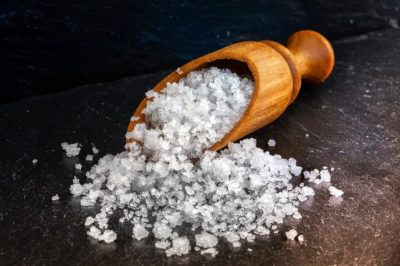
Excess salt (Figure 6) is recognized as a major factor in high blood pressure, cardiovascular disease, and stomach cancer. Reducing salt intake has been a key objective of successive National Nutrition and Health Programmes (PNNS). PNNS 3 (2011-2015) has thus set a target of 8 g/d of salt for men and 6.5 g/d for women and children, i.e. a 20% reduction in salt consumption compared to the average consumption of the French population.
Recently published work shows that the use of herbs and spices in a salt-reduced diet is an effective way to reduce salt consumption. When herbs and spices are included in the diet on a daily basis, there is a significant decrease in the amount of salt consumed and a decrease in urinary sodium excretion after 6 months [10]. In another trial, the perception of salty taste by the subjects enrolled in the study was modified by spicy flavours, allowing them to reduce their salt consumption while maintaining their taste pleasure. Clinically, this benefit is accompanied by a significant decrease in the participants’ blood pressure [11]. Finally, a recent English publication reports that the addition of herbs and spices to a soup with 53% less salt increases the acceptance and even palatability of the soup compared to an industrially salted soup [12].
Eating “high in taste” helps a wide audience to reduce salt intake, maintains palatability despite salt reduction, and prevents high blood pressure.
2.2. Herbs and spices to eat more vegetables
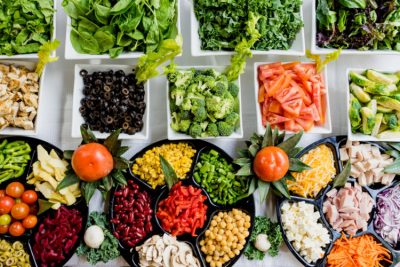
Increasing the consumption of fruits and vegetables is a key focus of nutrition recommendations (Figure 7). Consumption is stagnating in France despite repeated information campaigns. Taste is the primary motivation for choosing vegetables, with health or weight control generally being less of a priority. In an intervention trial conducted in overweight subjects who were small vegetable consumers (< 3 servings/d), eating spicy foods and using culinary herbs increased vegetable consumption, with the best results observed in subjects who were usually less fond of vegetables and who had a 91% increase in their consumption [13].
Important for the nutritional education of young subjects, several studies in children [14] and high school students [15], point out that adding herbs and spices to foods helps to consume unloved vegetables (celery and squash) and to get healthy food choices.
2.3. Herbs and spices to make it easier to eat lower-fat, lower-sweet foods

The epidemic of overweight and obesity is largely due to excessive consumption of fats and sugars, especially soft drinks (Figure 8). Two American studies, conducted in overweight volunteers, show that the palatability for lower-fat and less sweet foods seasoned with herbs and spices is increased, whereas it is decreased when the same food does not contain herbs and spices [16], [17].
3. Herbs and spices, our allies in preventing nutritional diseases
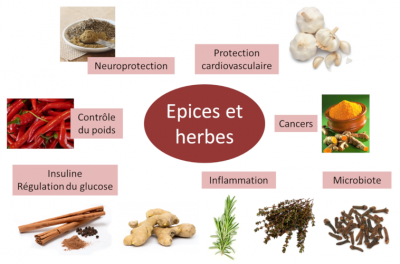
3.1. Herbs, spices and obesity
Certain spices, used regularly and in nutritional doses, take part in weight control through a triple mechanism: increased energy expenditure, increased thermogenesis and activation of fat-burning metabolisms.
The most frequently mentioned spices are cayenne pepper, rich in capsain [18] and ginger, rich in gingerols and shoagols [19]. It must be stressed that it is dangerous to exceed hedonic nutritional doses, i.e. those that provide gustatory pleasure, as excess capsinoids can lead to intestinal and gastric aggression with a burning sensation and an alteration of intestinal permeability leading to dysbiosis.
3. Herbs, Spices and Insulin Resistance: From Metabolic Syndrome to Type 2 Diabetes

It is scientifically established that several spices (cinnamon, turmeric, cumin, cloves, and recently cardamom, Figure 10) and Mediterranean herbs (laurel, tarragon, rosemary) regulate blood glucose, increase insulin sensitivity and improve biological markers of metabolic syndrome [21], [22], [23]. Let us give a special mention to cinnamon powder, of which 1g per day is enough to reduce the blood sugar levels of subjects with metabolic syndrome to physiological values [24].
3.3. Herbs, spices and cardiovascular disease
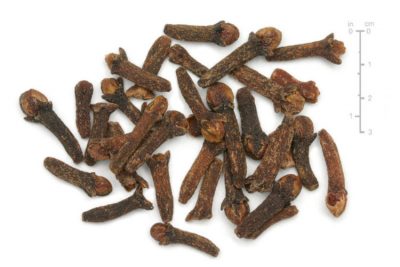
In terms of cardiovascular prevention, the most significant results are obtained with garlic in relation to its richness in organo-sulfur compounds [25]. Regular consumption of garlic in powder (600 mg/d) or clove (2.7 g/d) reduces cholesterol levels, decreases platelet aggregation, and has a hypotensive effect [26].
Cardamom, coriander, turmeric, ginger and cloves (Figure 11), consumed regularly, also help to prevent cardiovascular disease because these spices, as described in the previous paragraph, counteract the metabolic syndrome and its vascular consequences through their antioxidant and anti-inflammatory effects.
Moreover, the emerging role of turmeric in protecting the vascular endothelium seems to be due not only to its anti-inflammatory and antioxidant properties but also to the induction of the production of NO, a vasodilator and hypoaggregant [27].
3.4. Turmeric, Ginger and Inflammatory Diseases
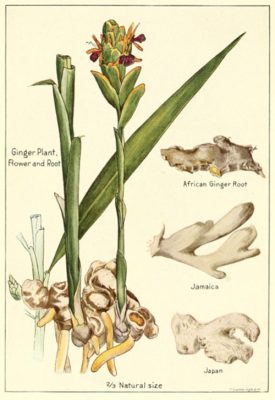
Ginger (Figure 12), rich in gingerols and shoagols, used in the form of rhizome powder at 2g/d for 3 weeks, significantly reduces chronic muscle pain [28].
Turmeric (Figure 13) and its active ingredient curcumin are powerful anti-inflammatory drugs that have been recognized for centuries by Ayurvedic Medicine [29]. However, the very poor bioavailability [30] of turmeric powder reduces its effectiveness and high doses, of the order of 10gr/d, are necessary. The properties of curcumin are validated by numerous international studies. Curcumin has been shown to be as effective as non-steroidal anti-inflammatory drugs (NSAIDs) in treating joint inflammation at 500mg/d [31].
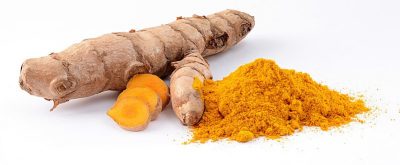
3.5. Herbs, spices and microbiota: the future
This research area is very promising. Diet is the main factor influencing the composition of the intestinal microbiota and so our health.
Several recent works, in vitro, in vivo, show that dietary polyphenols influence the abundance and nature of the intestinal bacterial flora. Dietary sources of polyphenols (tea, cocoa, fruit) reduce the number of pathogenic bacteria, and increase the number of beneficial bifidobacteria and lactobacilli. In this context, the prebiotic-like effect of a mixture of 7 spices and herbs (oregano, rosemary, turmeric, black pepper, cayenne pepper, cinnamon, ginger) has just been published and opens promising perspectives in the prevention and treatment of dysbiosis and intestinal permeability disorders [32].
4. Herbs, Spices and Health: Benefits and Limitations
Profits. Based on validated scientific studies, it appears that the regular consumption of aromatic herbs and spices brings many benefits to our Health. Aromatic herbs and spices :
- increase the nutritional quality of our food by protecting it from oxidation and the formation of carcinogenic compounds
- help develop healthy eating habits: less salt, sugars, fats and more vegetables
- take part, thanks to their antioxidant, anti-inflammatory and insulin-potentiating properties, in the prevention of :
- overweight,
- cardiovascular disease,
- of metabolic syndrome and type 2 diabetes,
- inflammatory diseases
- and recently demonstrated, intestinal dysbiosis.
The limits
- Effective daily doses with no side effects remain empirical and further intervention studies are needed to better define them
- The risk of contamination by pesticides and heavy metals should not be underestimated. It can be dangerous to consume imported herbs and spices without traceability in accordance with European legislation.
As a rule, the cultivation of spices requires few pesticides and herbicides. It is their storage that can represent a risk of toxicity with contamination by bacteria or microorganisms. Control of growing conditions, storage conditions and analytical quality are therefore essential.
These limits do not call into question the interest of the consumption of aromatic herbs and spices for human health, but they underline the dangers of not providing information in the field of nutrition as well as in the more general framework of our environment.
5. Messages to remember
- The regular use of culinary herbs and spices goes far beyond the simple search for taste pleasure, because introducing them into our eating habits, allows us to acquire healthy eating habits and participates in the nutritional prevention of non-communicable diseases with a nutritional component.
- However, clinical research still needs to progress as the optimal doses of herbs and spices in the prevention of pathologies and the mechanisms of action are not yet fully known.
Notes and References
Cover image. Spice market.
[1] Bruno Jarry, Spices. Hachette Pratique Publisher, 2007
2] HCSP: Pour une politique nutritionnelle de Santé Publique en France (PNNS 2017-2021). September 2017.
3] Hubert Richard, Spices and Aromatic Herbs, Planet-Vie, Wednesday, April 30, 2008, https://planet-vie.ens.fr/article/2061/epices-herbes-aromatiques
[4] http://www.reseau-education-gout.org/association-reseau-gout/IMG/pdf/dossier-mecanismes-degustation-jan12.pdf
[5] Opara E.L. & Chohan M., 2014, Culinary herbs and spices: their bioactive properties, the contribution of polyphenols and the challenges in deducing their true health benefits. Int. Mol. Sci. 15(10):19183-202.
[6] Oxidative stress corresponds to an aggression of the cells of our organism by species reactive to oxygen such as free radicals. Lifestyle, environmental factors and diet are the main risk factors for exposure to oxidative stress that attacks our cells. Several phytonutrients found in spices and herbs are antioxidants and have the property of preventing harmful chain reactions caused by free radicals.
[7] Yashin A., Yashin Y., Xia X. & Nemzer B., 2017, Antioxidant activity of spices and their impact on human health: A review. Antioxidants (Basel) 6(3).pii:E70; doi:10.3390/antiox6030070.Review.
[8] Li Z., Henning S.M., Zhang Y., Zerlin A., Li L., Gao K., Lee R.P., Karp H., Thames G., Bowerman S. & Heber D., 2010, Antioxidant-rich spice added to hamburger meat during cooking results in reduced meat, plasma, and urine malondialdehyde concentrations. Am..J Clin. Nutr. 91:1180-4
[9] Ninfali P., Mea G., Giorgini S., Rocchi M. & Bacchiocca M., 2005, Antioxidant capacity of vegetables, spices, and dressings relevant to nutrition. Br. J. Nutr. 93(2):257-266
[10] Anderson CA, Cobb LK, Miller ER, Woodward M, Hottenstein A, Chang AR, Mongraw-Chaffin M, White K, Charleston J, Tanaka T, Thomas L, Appel LJ. Effects of a behavioral intervention that emphasizes spices and herbs on adherence to recommended sodium intake: results of the SPICE randomized clinical trial. Am J Clin Nutr. 2015; 102(3):671-9
[11] Li Q, Cui Y. Enjoyment of spicy flavor enhances central salty-taste perception and reduces salt intake and blood pressure. Hypertension. 2017; 70(6):1291-9.
[12] Ghawi SK, Rowland I, Methven L. enhancing consumer liking of low salt tomato soup over repeated exposure by herbs and spice seasonings. Appetite. 2014; 81:20-29
[13] Li Z. et al, Food and Nutrition Sciences, 2015, 6,437-444
[14] Savage JS, Peterson J, Marini M, Bordi PL, Birch LL. The addition of a plain or herb-flavored reduced-fat dip is associated with improved preschooler’s intake of vegetables. J Acad Nutr Diet. 2013; 113(8):1090-5
[15] D’Adamo CR, Mc Ardle PF, Balick L, Peisach E, Ferguson T, Diehl A, Bustad K, Bowden B, Pierce BA, Berman BM. Spice my plate: nutrition education focusing upon spices and herbs improved diet quality and attitudes among urban high school students. Am J Health Promot.2016; 30(5):346-56
[16] Peters JC, Polsky S, Stark R, Zhaoxing P, Hill JO. The influence of herbs and spices on overall liking of reduced fat food. Appetite 2014; 79:183-8
[17] Alcaire F, Antunez L, Vidal L, Gimenez A, Ares G. Aroma-related cross-modal interactions for sugar reduction in milk desserts: influence of consumer perception. Food Res Int. 2017; 97:45-50.
[18] Varghese S., Kubatka P. & Rodrigo L., 2016, Chili pepper as a body weight- loss food. Int J Food Sci Nutr. Nov29: 1-10
[19] Wang J., Ke W., Bao R. & Chen F., 2017, Beneficial effect of ginger Zingiber officinale Roscoe on obesity and metabolic syndrome. Ann NY Acad Sci. 1398(1):83-89
[20] Insulin resistance: decreased sensitivity to insulin. As liver, muscle and fat cells become resistant to insulin, higher and higher amounts of insulin are needed to ensure that glucose enters the insulin-dependent cells, less glucose enters these cells and remains in the blood.
[21] Bi X., Lim J. & Henry C.J., 2017, Spices in the management of diabetes mellitus. Food Chem 217:281-93;
Fatemeh Y., Siassi F., Rahimi A., Koohdani F., Doostan F., Qorbani M. & Sotoudeh G., 2017, The effect of cardamom supplementation on serum-lipids, glycemic indices,and blood pressure in overweight and obese pre-diabetic women: a randomized controlled trial. J Diabetes Metab. Disord. Seven 29:16-40.
[22] Bower A., Marquez S. & de Mejia E.G., 2016, The health benefits of selected culinary herbs and spices found in the traditional mediterranean diet. Crit Rev Food Sci Nutr. 56(16:2728-46)
[23] Akilen R., Tsiami A., Devendra D. & Robinson N., 2012, Cinnamon in glycaemic control: systematic review and metaanalysis. Clin Nutr. 31(5):609-15.
[24] Bradley J.M., Organ C.L & Lefer D.J., 2016, Garlic-derived organic polysulfides and myocardial protection. J Nutr. 146(2):403S-409S
[25] Warshney R. & Budoff M.J., 2016, Garlic and heart diseases J Nutr. 146(2), 416S-421S
[26] Rastogi S., Pandey M.M. & Rawat AKS. 2017, Spices: Therapeutic potential in cardiovascular health. Curr Pharm Des. 23(7):989-998
[27] Campbell MS & Fleenor BS, 2017, The emerging role of curcumin for improving vascular dysfunction: a review. Crit Rev Food Sci Nutr. doi 10.1080/10408398-2017.1341865
[28] -Nahaim A, Jahan R & Rahmatullah M., 2014, Zingiber officinale: a potential plant against rheumatoid arthritis. Arthritis 159089.doi 10.1155/2014/159089
[29] Basnet P & Skalko-Basnet N., 2011, Curcumin: An anti-inflammatory molecule from a curry spice from inflammatory pathologies to cancer. Molecules 16(6):4567-98
[30] Bioavailability is defined as the fraction of the administered dose of active ingredient that reaches the systemic circulation and the rate at which it reaches the systemic circulation.
[31] Chin KY, 2016, The spice for joint inflammation: anti-inflammatory role of curcumin in treating osteoarthritis. Drug Des Develop Ther. Seven 20. 10:3029-3042.
[32] Lu QY, Summanen PH, Lee RP, Huang J, Henning SM, Heber D, Finegold SM & Li J., 2017, Prebiotic potential and chemical composition of seven culinary spice extracts. J Food Sci. Jul 5. Doi:10:1111/1750-3841;13792
The Encyclopedia of the Environment by the Association des Encyclopédies de l'Environnement et de l'Énergie (www.a3e.fr), contractually linked to the University of Grenoble Alpes and Grenoble INP, and sponsored by the French Academy of Sciences.
To cite this article: ROUSSEL Anne-Marie (April 20, 2020), Spices and aromatic herbs : what benefits for our health ?, Encyclopedia of the Environment, Accessed July 27, 2024 [online ISSN 2555-0950] url : https://www.encyclopedie-environnement.org/en/health/spices-aromatic-herbs-benefits-health/.
The articles in the Encyclopedia of the Environment are made available under the terms of the Creative Commons BY-NC-SA license, which authorizes reproduction subject to: citing the source, not making commercial use of them, sharing identical initial conditions, reproducing at each reuse or distribution the mention of this Creative Commons BY-NC-SA license.








